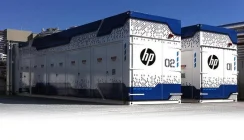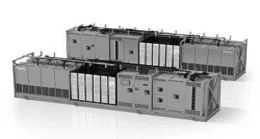What Is A Containerised Modular Data Centre?
Modular Data Centres (MDCs) use standardised critical infrastructure systems and pre-engineered containers or cabins to provide a data centre that can be transported to its point of use and is more easily scalable than a traditional ‘bricks and mortar’ facilities. The roll outs of Edge computing and 5G provide further opportunities for the adoption of this type of data centre facility.
A Containerised Environment For Critical Infrastructure Systems
Data centres provide a protected and managed environment housing a server room type environment and all the associated support services. When organisations need to deploy a data centre, they can either build or refurbish a ‘bricks and mortar’ facility or look at a containerised system or purpose-built metal cabin.
The containerised approach is not new when it comes to housing equipment external to a building. The concept has been around for many years and within a datacentre environment can be seen housing standby power generators. This type of container needs very little fit out in terms of fitting. Generators are robust systems and the container provides a secure housing to the system. The only fit-out could include lighting and LV switchgear for electrical connectivity to the power paths in the data centre.
The next iteration of the containerised concept is a considered UPS system and generator arrangement. To include an uninterruptible power supply within the container requires some form of cooling system to be added. This is to keep the ambient environment within 20-25˚C to protect the battery set which is typically a valve regulated lead acid battery type. Without adequate cooling the batteries would ‘cook’ inside the container and their working life would be dramatically reduced.
A combined UPS and generator containerised system is an ideal way to deploy power protection onto remote areas or for use as a temporary critical power supply. The UPS and generators could also be split into separate containers. The use of cooling within the UPS container also provides a more suitable working environment for local technicians and engineers.
The modular data centre is an extension of this approach. The components include every system you would expect to find within a ‘bricks and mortar’ facility including:
- HV/LV switchgear and electrical connectivity
- Uninterruptible power protection in the form of a centralised UPS system with or without a local standby power generator
- Some form of HVAC air conditioning for cooling and if necessary heating for extreme cold areas.
- Lighting and emergency lighting
- Access control and CCTV security systems
- A fire suppression system
- Aisle arrangements for server racks
- Network connectivity
Furthermore many if not all the systems and component used within the container are ‘off-the-shelf’ and are pre-configured before the installation. The only other components to add being the IT servers and any associated network and IT connectivity peripherals.
Types of Container Solution Available
When a containerised environment is required the principle route has been to use a refurbished ISO 20 or 40foot shipping container. Shipping containers are ideal as they are designed to protect goods whilst in transit and in the harshest of environments and extremes. The use of a fully refurbished container is environmentally friendly, and the refurbishment process ensures that the ‘building’ is free of any corrosion or damage caused from its first use as a shipping container.
This approach is suitable for generator and UPS system housing but may not be for some datacentre operators. Whilst the design concept for a shipping container is ideal, it may be that the data centre operator doesn’t want a refurbished container or requires something a little more bespoke to their application and fit-out. Here a purpose built container style design is the solution. The overall concept may look like a shipping container or a modified form of the design. As an alternative the data centre could be fitted into a metal building similar to that use for a packaged substation or HV/LV connections on a wind turbine or solar PV farm to the grid. Once again the design is robust, designed to withstand harsh environments and to provide a secure and temperature managed facility.
Modular Server Rooms In A Box
There can be several reasons for wanting to use the modular approach. For large data centre operators the arrangement allows for rapid scalability and deployment. Using a fixed design and pre-engineered systems means that a ‘standardised’ POD solution can be deployed easily. In terms of data centre roll out this can be within twenty percent of the time it takes for a ‘bricks and mortar’ based data centre facility. It is the type of arrangement favoured by some hyperscale cloud providers like Amazon Web Services (AWS).
Modular and containerised systems can also impact far smaller organisations. The approach can provide data centre facilities:
- In remote and rural areas where there is little existing infrastructure
- Where temporary facilities are required during a maintenance period, data centre refurbishment or as part of a disaster recovery (DR) plan.
- Where there is limited on-site space or budget to build a more traditional facility.
The modular datacentre approach provides the ability to respond dynamically to changing demands and environments and can shorten planning application and deployment timescales.
Summary
The modular data centre approach is more flexible and dynamic than a ‘bricks and mortar’ building. The approach is bespoke allowing for custom arrangements on site but using pre-engineered and standardised modules, systems and components. This can lead to not only a faster deployment period but also a reduced capital expenditure with potentially up to 50% less CAPEX.
The modular concept also allows for ‘pay-as-you-grow’. Not all the racks have to be fitted-out from day-one to allow further servers to be commissioned as required. In additional further containers can be added to the installation as required in the future.
The introduction of 5G and Edge computing will see an increase in the use of ‘server rooms in a box’ in order to capitalise on the benefits of the latest generation mobile and Wi-Fi technologies. This means that roadside micro and modular data centres may become as common as the green fibre boxes and electrical substations we have today. Few realise they are there but almost everyone is reliant on them during some part of their day.


























